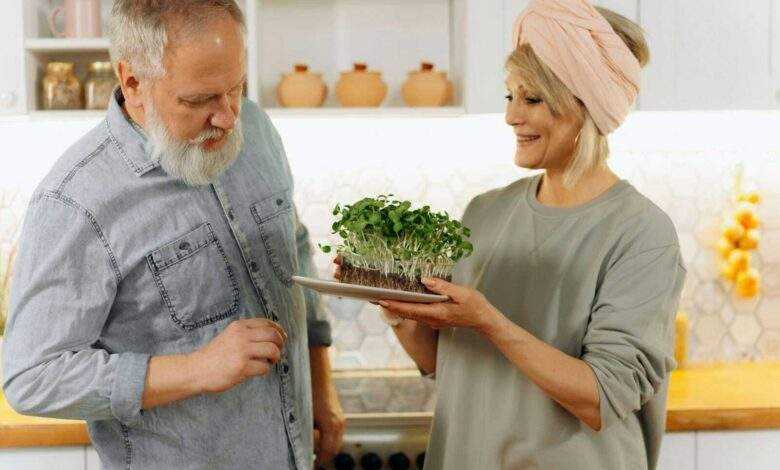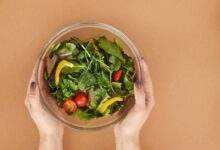The Power of Herbs: Grow Herbs at Home for Fresh Flavor and Sustainability

Table of Contents
Have you ever dreamt of infusing your dishes with the vibrant aroma and bursting flavor of freshly picked herbs? Craved the satisfaction of nurturing life and adding a touch of green to your living space? Then look no further than your own windowsill! Welcome to the wonderful world of indoor herb gardening, where the magic of fresh, homegrown herbs awaits.
Growing your own herbs isn’t just about convenience; it’s a journey of culinary creativity and sustainable living. Imagine snipping a sprig of fragrant basil for your next homemade pizza, or adding a touch of lively cilantro to your favorite salsa. Every harvest is a celebration of your nurturing touch, and with minimal effort, you’ll be reaping the rewards of vibrant flavor and culinary confidence.
Whether you’re a seasoned cook or just starting your culinary adventure, this guide will be your companion on the path to a thriving indoor herb haven. We’ll delve into everything you need to know, from selecting the perfect herbs for your taste buds to ensuring they flourish under your care. So, grab your gardening gloves (or maybe just your favorite mug!), settle in, and let’s unlock the power of herbs together!
A. The Allure of Fresh Herbs
Fresh herbs bring an unmatched burst of flavor and aroma to culinary creations, surpassing dried varieties in many ways. The essential oils in fresh herbs are more potent, providing a brighter and more nuanced taste. When used fresh, herbs like basil, cilantro, and mint can transform dishes, adding vibrancy and complexity that dried herbs simply cannot match. For example, fresh basil enhances the flavor of a Caprese salad far more effectively than its dried counterpart, offering a more robust and aromatic experience.
Relevant Resources:
- Epicurious: Fresh vs. Dried Herbs
- Bon Appétit: Fresh vs. Dried Herbs in Cooking
B. Beyond the Plate: The Multiple Benefits of Homegrown Herbs
Freshness and Flavor at Your Fingertips
Homegrown herbs allow you to harvest only what you need, ensuring peak freshness and flavor. Imagine stepping into your kitchen, snipping a few sprigs of rosemary for a roast, and knowing that they are at their most flavorful. This immediacy can elevate your cooking, making every meal special.
Fresh herbs can be used in a wide range of dishes, enhancing their taste and presentation. For instance, a fresh sprig of mint can brighten up a fruit salad, while a handful of chopped cilantro can add a refreshing kick to a salsa or guacamole. The ability to harvest herbs at the peak of their flavor also means that you can experiment with new recipes and culinary techniques, knowing that you have the freshest ingredients at your disposal.
Sustainability in Your Kitchen
Growing your own herbs reduces the need for plastic packaging and transportation emissions associated with store-bought herbs. By cultivating herbs at home, you contribute to a more sustainable kitchen, reducing your carbon footprint.
In addition to reducing packaging waste, growing your own herbs also allows you to control the growing conditions, ensuring that no harmful pesticides or chemicals are used. This can result in healthier and safer ingredients for your meals. Furthermore, by composting kitchen scraps and using them as fertilizer, you can create a closed-loop system that minimizes waste and maximizes resource efficiency.
Relevant Resources:
- National Geographic: Benefits of Growing Your Own Food
- Gardeners’ World: How Growing Plants Can Improve Your Wellbeing
Cost-Effective Culinary Creativity
Initial investments in seeds or seedlings pay off over time, as you continuously harvest fresh herbs without repeated grocery purchases. Over a growing season, this can result in significant savings, particularly with high-use herbs like basil and parsley.
Growing your own herbs also allows you to experiment with a wider variety of herbs that may not be readily available in stores. For example, you can grow exotic herbs like Thai basil, lemon balm, or lemon verbena, expanding your culinary repertoire and enabling you to create more diverse and interesting dishes.
A Greener Thumb and a Happy Home
Gardening offers therapeutic benefits, from reducing stress to improving mood. Nurturing plants fosters a connection with nature, providing a rewarding and calming hobby. Additionally, having a variety of fresh herbs on hand can inspire culinary creativity, encouraging healthier eating habits.
Studies have shown that gardening can have numerous mental and physical health benefits, including reduced symptoms of depression and anxiety, improved cognitive function, and increased physical activity. By incorporating herb gardening into your daily routine, you can enjoy these benefits while also enhancing your cooking and eating habits.
Relevant Resources:
- National Gardening Association: Benefits of Gardening
- University of Minnesota: How Gardening Improves Your Health
II. Planning Your Indoor Herb Haven
A. Choosing the Perfect Herbs for You
Popular Indoor Herb Champions
Starting with beginner-friendly herbs ensures early success in your indoor herb garden. Some of the easiest and most versatile herbs to grow indoors include:
- Basil: Ideal for Italian dishes, salads, and pesto. Basil thrives in warm, sunny environments and can be grown year-round indoors with adequate light.
- Mint: Perfect for teas, desserts, and Middle Eastern cuisine. Mint is a hardy herb that grows quickly and can tolerate partial shade.
- Cilantro: Essential for Mexican and Asian recipes. Cilantro prefers cooler temperatures and partial shade, making it suitable for indoor cultivation.
- Parsley: A versatile garnish and ingredient in various dishes. Parsley can be grown in pots and requires moderate sunlight and regular watering.
- Chives: Adds a mild onion flavor to salads, soups, and omelets. Chives are easy to grow and can tolerate a variety of light conditions.
- Oregano: A staple in Mediterranean cooking, particularly in sauces and meat dishes. Oregano is a hardy herb that prefers full sun and well-drained soil.
Matching Herbs to Your Culinary Style
Select herbs based on your preferred cuisines and cooking habits. If you frequently prepare Italian dishes, basil, oregano, and parsley should be staples in your herb garden. For those who enjoy Asian cuisine, cilantro, mint, and Thai basil are excellent choices.
Consider the flavors and aromas that you use most often in your cooking, and choose herbs that complement your favorite dishes. For example, if you love making homemade salsa, cilantro and chives are essential. If you enjoy baking, consider growing mint and lemon balm for adding fresh flavors to desserts and beverages.
Relevant Resources:
- The Spruce: Best Herbs to Grow Indoors
- Gardening Know How: Indoor Herb Gardens
B. Location, Location, Location: Setting the Stage for Success
Light It Up
Light is crucial for the healthy growth of herbs. Most herbs require at least 6 hours of direct sunlight each day. Place your herb garden near a south-facing window for optimal light exposure. If natural light is insufficient, consider using grow lights to supplement.
Grow lights are available in various types, including fluorescent, LED, and incandescent. LED grow lights are energy-efficient and provide a full spectrum of light, making them ideal for indoor herb gardening. Position the lights 6-12 inches above the herbs and adjust as the plants grow.
Relevant Resources:
- Better Homes & Gardens: How to Grow Herbs Indoors
- Gardener’s Supply Company: Indoor Herb Gardening Tips
Temperature Talk
Herbs generally thrive in temperatures between 60-70°F (15-21°C). Avoid placing your herbs near drafts or heating vents, as sudden temperature changes can stress the plants.
Maintaining consistent temperature and humidity levels is important for healthy herb growth. Use a thermometer and hygrometer to monitor the growing conditions and make adjustments as needed. If the indoor air is too dry, consider using a humidifier to maintain the optimal humidity level.
Relevant Resources:
- The Old Farmer’s Almanac: Growing Herbs Indoors
- University of Minnesota: Indoor Gardening Guide
C. Selecting Your Herb Garden’s Home
Container Considerations
Choosing the right containers is essential for healthy herb growth. Terracotta, ceramic, and recycled containers are all viable options, each offering different aesthetic and practical benefits. Ensure containers have proper drainage to prevent waterlogging and root rot.
Terracotta pots are porous, allowing air and moisture to pass through the walls, which can help prevent overwatering. Ceramic pots are non-porous and come in a variety of colors and designs, making them a stylish choice for indoor herb gardens. Recycled containers, such as tin cans or plastic bottles, can be repurposed into unique and eco-friendly herb planters.
Relevant Resources:
- The Spruce: Best Containers for Growing Herbs
- Gardening Know How: Choosing Containers for Herbs
Vertical Herb Gardens
Vertical planters and hanging gardens are excellent space-saving solutions, allowing you to grow multiple herbs even in small areas. These setups not only maximize space but also create an attractive display.
Vertical herb gardens can be created using wall-mounted planters, tiered shelves, or hanging pots. These arrangements are ideal for small spaces and can add a decorative element to your home. Additionally, vertical gardening can improve air circulation and reduce the risk of pests and diseases.
Relevant Resources:
- Vertical Garden Guide: DIY Vertical Herb Gardens
- Houzz: Vertical Herb Garden Ideas
D. Soil vs. Hydroponics: Choosing Your Cultivation Method
The Simplicity of Soil
Growing herbs in soil
is straightforward and beginner-friendly. Use a well-draining potting mix specifically formulated for herbs. Regularly check the soil moisture and ensure proper drainage to prevent waterlogged roots.
Soil-based herb gardening allows for a more natural growing environment, providing the roots with essential nutrients and microorganisms. Choose a high-quality potting mix that includes organic matter and perlite or vermiculite for improved drainage and aeration.
Relevant Resources:
- Better Homes & Gardens: Best Potting Soil for Herbs
- Gardening Know How: How to Grow Herbs in Soil
The Allure of Hydroponics
Hydroponic systems grow herbs in a nutrient-rich water solution, eliminating the need for soil. This method allows for faster growth and can be ideal for those with limited space. Hydroponic systems require careful monitoring of water quality and nutrient levels.
Hydroponic herb gardening can be more efficient in terms of water usage and space requirements. Systems like nutrient film technique (NFT), deep water culture (DWC), and aeroponics offer various options for growing herbs hydroponically. These systems can be set up indoors with grow lights to provide the necessary light for healthy growth.
Relevant Resources:
- Hydroponics Simplified: Hydroponic Herb Gardening
- Epic Gardening: Beginner’s Guide to Hydroponic Herbs
III. Planting and Nurturing Your Herb Oasis
A. Seeds or Seedlings: Deciding Your Starting Point
Seed Starting 101
Starting herbs from seeds offers the satisfaction of nurturing plants from their earliest stages. Follow these steps for successful seed starting:
- Choose Quality Seeds: Purchase seeds from reputable sources to ensure high germination rates.
- Prepare Containers: Use seed trays, small pots, or recycled containers with drainage holes.
- Fill with Potting Mix: Fill the containers with a well-draining seed starting mix.
- Plant Seeds: Follow the seed packet instructions for planting depth and spacing.
- Water Gently: Moisten the soil without waterlogging. Use a spray bottle for gentle watering.
- Provide Light: Place the containers in a sunny spot or under grow lights.
- Maintain Temperature: Keep the soil consistently warm, around 70°F (21°C), for optimal germination.
Relevant Resources:
- The Old Farmer’s Almanac: Starting Seeds Indoors
- Gardening Know How: How to Start Herb Seeds
The Convenience of Seedlings
Using pre-grown seedlings provides a head start, offering quicker results and reducing the risk of germination failures. Seedlings are readily available at garden centers and nurseries.
Transplant seedlings into their permanent containers as soon as possible, ensuring that they have enough space to grow. Gently loosen the roots before planting and water thoroughly after transplanting.
Relevant Resources:
- The Spruce: How to Transplant Seedlings
- Gardener’s Path: Transplanting Seedlings Guide
B. Planting Techniques for Thriving Herbs
Sowing Seeds Like a Pro
To sow seeds successfully, follow these steps:
- Prepare Containers: Use seed trays, small pots, or recycled containers with drainage holes.
- Fill with Potting Mix: Fill the containers with a well-draining seed starting mix.
- Plant Seeds: Follow the seed packet instructions for planting depth and spacing.
- Water Gently: Moisten the soil without waterlogging. Use a spray bottle for gentle watering.
- Provide Light: Place the containers in a sunny spot or under grow lights.
- Maintain Temperature: Keep the soil consistently warm, around 70°F (21°C), for optimal germination.
Relevant Resources:
- The Spruce: How to Sow Herb Seeds
- Better Homes & Gardens: Sowing Seeds Indoors
Transplanting Seedlings for Success
Transplanting seedlings into their permanent containers requires careful handling to avoid damaging the roots. Follow these steps:
- Choose the Right Time: Transplant seedlings when they have at least two sets of true leaves.
- Prepare Containers: Fill the permanent containers with well-draining potting mix.
- Loosen Roots: Gently loosen the roots of the seedlings before planting.
- Plant Seedlings: Place the seedlings in the prepared containers at the same depth as they were in their original pots.
- Water Thoroughly: Water the seedlings immediately after transplanting to help them settle in.
Relevant Resources:
- The Spruce: How to Transplant Herb Seedlings
- Gardening Know How: Transplanting Herb Seedlings
Utilizing Kitchen Scraps for Herb Reinvention
Regrowing herbs from kitchen scraps is an eco-friendly and cost-effective way to expand your herb garden. Follow these steps:
- Choose Healthy Scraps: Select healthy stems or roots from herbs like basil, mint, or green onions.
- Prepare Containers: Use small pots or jars filled with water or potting mix.
- Place Scraps in Water: For water propagation, place the cut ends of the scraps in water and change the water every few days.
- Transfer to Soil: Once roots develop, transplant the scraps into pots filled with potting mix.
- Provide Light and Water: Place the containers in a sunny spot and water regularly.
Relevant Resources:
- Better Homes & Gardens: How to Regrow Herbs from Scraps
- Gardening Know How: Regrowing Herbs from Kitchen Scraps
IV. Cultivating Happy and Healthy Herbs
A. Watering Wisdom: Keeping Your Herbs Hydrated
Understanding Watering Needs
Different herbs have varying water requirements. For example, Mediterranean herbs like rosemary and thyme prefer drier conditions, while basil and mint need more consistent moisture.
To ensure proper hydration, water your herbs when the top inch of soil feels dry. Use a watering can with a narrow spout to direct water to the base of the plants, avoiding the leaves to prevent mold and mildew.
Relevant Resources:
- The Spruce: How to Water Indoor Plants
- Better Homes & Gardens: Watering Tips for Herbs
Signs of Thirsty Herbs
Thirsty herbs may exhibit signs such as wilting, yellowing leaves, or dry, brittle stems. Check the soil moisture regularly and adjust your watering schedule as needed.
If you notice your herbs are wilting, increase the frequency of watering and ensure the soil is evenly moist. For herbs with yellowing leaves, check for overwatering or nutrient deficiencies.
Relevant Resources:
- Gardening Know How: Signs of Underwatered Plants
- The Spruce: How to Revive Wilting Plants
Avoiding Overwatering Woes
Overwatering can lead to root rot and other issues. Ensure your containers have proper drainage and avoid letting your herbs sit in standing water. Allow the soil to dry out slightly between waterings.
To prevent overwatering, use a moisture meter to check the soil moisture level before watering. Additionally, ensure that your containers have drainage holes and use a well-draining potting mix.
Relevant Resources:
- The Spruce: How to Avoid Overwatering Plants
- Gardening Know How: Preventing Root Rot
B. Sunlight Savvy: Ensuring Proper Light Exposure
Mimicking the Outdoors
To replicate natural sunlight patterns for indoor herbs, place them near south-facing windows for maximum light exposure. Rotate the pots regularly to ensure even growth.
If natural light is insufficient, consider using grow lights to supplement. LED grow lights are energy-efficient and provide a full spectrum of
light, making them ideal for indoor herb gardening.
Relevant Resources:
- Better Homes & Gardens: Best Lighting for Indoor Plants
- The Spruce: How to Use Grow Lights for Indoor Plants
Supplemental Lighting Solutions
Supplemental lighting can be essential, especially during winter months. LED grow lights are a popular choice due to their energy efficiency and full-spectrum light. Position the lights 6-12 inches above the herbs and adjust as the plants grow.
Use a timer to ensure your herbs receive 12-16 hours of light per day, mimicking the natural daylight cycle. Adjust the height of the grow lights as the plants grow to maintain optimal light exposure.
Relevant Resources:
- Gardener’s Supply Company: Indoor Grow Light Guide
- Epic Gardening: Best Grow Lights for Indoor Plants
C. The Art of Fertilization
Natural and Organic Options
Natural fertilizers like compost tea, worm castings, and fish emulsion provide essential nutrients without the risk of chemical buildup. Apply fertilizers sparingly to avoid nutrient burn.
Compost tea is a nutrient-rich liquid made from steeping compost in water, providing a gentle and effective fertilizer for herbs. Worm castings, also known as vermicompost, are rich in essential nutrients and beneficial microorganisms that improve soil health. Fish emulsion is a liquid fertilizer made from fish waste, offering a balanced nutrient profile for healthy herb growth.
Relevant Resources:
- The Spruce: Best Organic Fertilizers for Herbs
- Gardening Know How: How to Use Worm Castings
Less is More
Over-fertilizing can harm herbs, leading to nutrient burn and weakened plants. Use fertilizers sparingly and follow the manufacturer’s instructions for application rates. Regularly monitor your herbs for signs of nutrient deficiencies or excesses and adjust your fertilization schedule accordingly.
To avoid over-fertilization, start with half the recommended dose and gradually increase as needed. Monitor your herbs for signs of nutrient deficiencies, such as yellowing leaves or stunted growth, and adjust your fertilization schedule accordingly.
Relevant Resources:
- The Spruce: How to Fertilize Indoor Plants
- Better Homes & Gardens: Fertilizing Tips for Herbs
V. Harvesting and Using the Bounty of Your Herb Garden
A. When and How to Harvest Your Herbs for Peak Flavor
Timing is Key
Harvest herbs when their essential oils are at their peak for maximum flavor. For most herbs, this is just before the plant flowers. Early morning is the best time to harvest, as the oils are most concentrated.
Regularly harvesting your herbs encourages new growth and prevents the plants from becoming woody or bitter. For herbs like basil and mint, pinch off the top leaves to promote bushier growth. For perennial herbs like rosemary and thyme, trim the stems to encourage branching and prevent leggy growth.
Relevant Resources:
- The Spruce: When to Harvest Herbs
- Gardening Know How: How to Harvest Herbs
Harvesting Techniques
Proper harvesting techniques encourage healthy regrowth. Use sharp scissors or pruning shears to cut stems just above a leaf node. This promotes branching and fuller growth.
For leafy herbs like basil, mint, and parsley, regularly trim the top leaves to encourage bushier growth. For woody herbs like rosemary, thyme, and sage, trim the stems back by about one-third to maintain a compact shape and encourage new growth.
Relevant Resources:
- Better Homes & Gardens: How to Harvest Herbs
- The Spruce: Best Ways to Harvest Herbs
B. Culinary Canvas: Incorporating Fresh Herbs into Your Dishes
Fresh Herb Pairings
Pairing herbs with complementary ingredients enhances the flavor of your dishes. For example, basil pairs well with tomatoes, mint with lamb, and rosemary with roasted potatoes. Experiment with different combinations to find your favorites.
Consider the flavors and aromas of different herbs and how they can enhance your dishes. For example, thyme adds a savory depth to roasted vegetables and meats, while dill adds a fresh, tangy flavor to fish and salads. Experiment with different herb combinations to create unique and delicious dishes.
Relevant Resources:
- The Kitchn: Guide to Cooking with Fresh Herbs
- Better Homes & Gardens: Herb Pairing Guide
Fresh Herb Recipes for Inspiration
Incorporate fresh herbs into your dishes with these simple recipes:
- Basil Pesto: Blend fresh basil leaves, garlic, pine nuts, Parmesan cheese, and olive oil for a versatile sauce.
- Mint Yogurt Dip: Mix chopped mint leaves with Greek yogurt, lemon juice, and a pinch of salt for a refreshing dip.
- Rosemary Roasted Potatoes: Toss potato wedges with olive oil, chopped rosemary, salt, and pepper. Roast until crispy and golden.
Relevant Resources:
- Allrecipes: Fresh Herb Recipes
- Epicurious: Cooking with Fresh Herbs
VI. Beyond the Kitchen: Expanding Your Herb Garden’s Uses
A. Aromatic Accents: Fresh Herbs for Home Fragrance
Natural Potpourri
Create natural potpourri by drying herbs like lavender, rosemary, and thyme. Combine the dried herbs with essential oils and other aromatic ingredients for a fragrant blend to place in sachets or bowls.
Drying herbs for potpourri is a simple process that preserves their fragrance for months. Hang bundles of herbs upside down in a cool, dark place until they are fully dried. Once dried, mix the herbs with other aromatic ingredients, such as dried flowers, citrus peels, and spices, to create custom potpourri blends.
Relevant Resources:
- Better Homes & Gardens: How to Make Potpourri
- The Spruce: DIY Potpourri Recipes
Herb-Infused Cleaning Solutions
Use herbs like lavender, rosemary, and mint to make homemade cleaning solutions. Infuse vinegar or water with fresh herbs to create natural, fragrant cleaners for your home.
Herb-infused cleaning solutions are an eco-friendly alternative to commercial cleaners. To make an herbal vinegar cleaner, fill a jar with fresh herbs and cover them with white vinegar. Let the mixture sit for two weeks, then strain out the herbs and dilute with water. Use the solution to clean countertops, windows, and other surfaces.
Relevant Resources:
- The Kitchn: DIY Herbal Cleaning Spray
- Better Homes & Gardens: Natural Cleaning Solutions
VII. Designing Your Indoor Herb Oasis
A. Creating an Aesthetic Herb Haven
Choosing Containers for Style
Select containers that complement your home décor while providing the necessary drainage for healthy herb growth. Options include terracotta pots, decorative ceramic pots, and repurposed containers.
Consider the style and color scheme of your home when choosing containers. For a rustic look, opt for terracotta or wooden planters. For a modern aesthetic, choose sleek, minimalist pots in neutral colors. Mixing and matching different container styles can add visual interest to your indoor herb garden.
Relevant Resources:
- The Spruce: Best Planters for Indoor Herb Gardens
- Better Homes & Gardens: Stylish Indoor Planters
Herb Garden Arrangements
Arrange your herbs in an aesthetically pleasing manner, considering height, color, and texture. Group taller herbs like basil and rosemary in the back, with shorter herbs like chives and thyme in the front.
Create a visually appealing herb garden by arranging your plants based on their growth habits and visual characteristics. Group herbs with similar light and water requirements together to make maintenance easier. Consider using tiered shelves or multi-level plant stands to showcase your herbs and create a dynamic display.
Relevant Resources:
- The Spruce: How to Arrange Indoor Plants
- Better Homes & Gardens: Herb Garden Design Ideas
B. Functional and Stylish Herb Displays
Vertical Gardens and Hanging Planters
Maximize space with vertical gardens or hanging planters. These options are ideal for small spaces and can add a green, lively touch to your home décor.
Vertical gardens and hanging planters are perfect for small spaces and can add a touch of greenery to any room. Use wall-mounted planters, hanging baskets, or vertical plant stands to create a lush, green display. Choose lightweight pots and secure them properly to ensure they are safe and stable.
Relevant Resources:
- The Spruce: How to Create a Vertical Herb Garden
- Better Homes & Gardens: Hanging Herb Garden Ideas
DIY Herb Garden Projects
Get creative with DIY herb garden projects, such as repurposing old furniture or using mason jars as planters. These unique displays can add a personal touch to your indoor herb garden.
DIY herb garden projects allow you to customize your indoor garden to suit your style and space. Repurpose items like wooden crates, pallets, or old bookshelves to create unique planters. Use mason jars, tin cans, or teacups as creative containers for individual herbs. Add decorative labels or signs to personalize your garden and make it truly your own.
Relevant Resources:
- The Spruce: DIY Indoor Herb Garden Ideas
- Better Homes & Gardens: DIY Herb Garden Projects
Frequently Asked Questions (FAQ)
1. I’m a complete beginner. Can I still grow herbs indoors?
Absolutely! Indoor herb gardens are a fantastic option for beginners. This guide focuses on easy-to-care-for herbs that thrive with minimal effort. We’ll provide step-by-step instructions and helpful tips to ensure your herb garden flourishes, even if you’re new to the world of gardening.
2. Which herbs are best suited for indoor growing?
Many herbs love the consistent warmth and sunlight conditions found indoors. Popular choices include basil, mint, cilantro, parsley, chives, oregano, and thyme. This guide will explore a variety of herbs suited for different tastes and culinary preferences.
3. How much sunlight do my indoor herbs need?
Light is crucial for healthy herb growth. Most herbs require around 6-8 hours of bright, indirect sunlight daily. South-facing windows are ideal, but with a little creativity, you can find suitable spots in your home. We’ll discuss alternative solutions like using supplemental grow lights if needed.
4. What kind of container should I use for my herbs?
There’s a range of container options to suit your style and space. Well-draining pots made of terracotta, ceramic, or even recycled materials are all great choices. For smaller spaces, vertical planters or hanging gardens are space-saving solutions. We’ll delve into the pros and cons of different container types to help you find the perfect fit.
5. Should I use soil or hydroponics for my indoor herbs?
Both methods have their merits! For beginners, well-draining potting mix is a simple and effective option. Hydroponics offers a more technical approach, but can be rewarding for experienced gardeners. This guide will explain the advantages and considerations for each method to help you decide.
6. How often do I need to water my indoor herbs?
The frequency of watering depends on the specific herb, pot size, and environmental factors. A good rule of thumb is to water when the top inch of soil feels dry to the touch. We’ll provide tips on recognizing signs of underwatering and overwatering to keep your herbs happy and healthy.
7. Do I need to fertilize my indoor herbs?
While not essential, occasional fertilization can give your herbs a boost. Opt for natural or organic fertilizers like compost tea or worm castings. Remember, a little goes a long way – over-fertilizing can harm your plants. We’ll offer guidance on when and how much fertilizer to use.
8. When and how should I harvest my herbs?
Harvesting at the right time ensures the best flavor and encourages continued growth. We’ll provide tips on identifying the optimal harvest window for different herbs, along with proper harvesting techniques that promote healthy regrowth.
9. What can I do with my harvested herbs besides using them in cooking?
Fresh herbs offer a multitude of uses beyond the kitchen! They can be used to create fragrant sachets for drawers and closets, or even incorporated into homemade cleaning solutions. We’ll explore some creative ways to get the most out of your homegrown herbs.
10. What if my herbs start to look wilted or discolored?
Don’t despair! Many factors can affect herb health. We’ll provide troubleshooting tips to identify common problems like underwatering, overwatering, or lack of sunlight. With a little investigation and adjustments, you can get your herbs back on track.
By now, you’re likely brimming with the excitement to cultivate your very own herb garden! This guide has equipped you with the knowledge and tools to embark on this rewarding journey. Remember, nurturing a thriving herb haven is all about patience, observation, and a sprinkle of love. Don’t be discouraged by minor setbacks – embrace them as learning opportunities!
As you watch your herbs flourish, revel in the satisfaction of creating a sustainable source of fresh flavor. With every snip, you’ll be adding a touch of green magic to your dishes, reducing your environmental footprint, and connecting with the joy of nurturing life. So, what are you waiting for? Dive into the world of indoor herb gardening and discover the endless possibilities it holds!
And remember, as you embark on this adventure, we’re always here to cheer you on. Feel free to revisit this guide for inspiration or delve deeper into specific topics with further research. Happy herb gardening!








